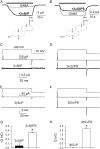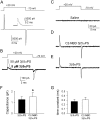Effects on membrane capacitance of steroids with antagonist properties at GABAA receptors
- PMID: 18339741
- PMCID: PMC2426621
- DOI: 10.1529/biophysj.107.124768
Effects on membrane capacitance of steroids with antagonist properties at GABAA receptors
Abstract
We investigated the electrophysiological signature of neuroactive steroid interactions with the plasma membrane. We found that charged, sulfated neuroactive steroids, those that exhibit noncompetitive antagonism of GABA(A) receptors, altered capacitive charge movement in response to voltage pulses in cells lacking GABA receptors. Uncharged steroids, some of which are potent enhancers of GABA(A) receptor activity, produced no alteration in membrane capacitance. We hypothesized that the charge movements might result from physical translocation of the charged steroid through the transmembrane voltage, as has been observed previously with several hydrophobic anions. However, the charge movements and relaxation time constants of capacitive currents did not exhibit the Boltzmann-type voltage dependence predicted by a single barrier model. Further, a fluorescently tagged analog of a sulfated neurosteroid altered membrane capacitance similar to the parent compound but produced no voltage-dependent fluorescence change, a result inconsistent with a strong change in the polar environment of the fluorophore during depolarization. These findings suggest that negatively charged sulfated steroids alter the plasma membrane capacitance without physical movement of the molecule through the electric field.
Figures






Similar articles
-
Hydrophobic anions potently and uncompetitively antagonize GABA(A) receptor function in the absence of a conventional binding site.Br J Pharmacol. 2011 Sep;164(2b):667-80. doi: 10.1111/j.1476-5381.2011.01396.x. Br J Pharmacol. 2011. PMID: 21457224 Free PMC article.
-
The influence of neuroactive steroid lipophilicity on GABAA receptor modulation: evidence for a low-affinity interaction.J Neurophysiol. 2009 Aug;102(2):1254-64. doi: 10.1152/jn.00346.2009. Epub 2009 Jun 24. J Neurophysiol. 2009. PMID: 19553485 Free PMC article.
-
A synthetic 18-norsteroid distinguishes between two neuroactive steroid binding sites on GABAA receptors.J Pharmacol Exp Ther. 2010 May;333(2):404-13. doi: 10.1124/jpet.109.164079. Epub 2010 Feb 2. J Pharmacol Exp Ther. 2010. PMID: 20124410 Free PMC article.
-
Mechanisms of neurosteroid interactions with GABA(A) receptors.Pharmacol Ther. 2007 Oct;116(1):35-57. doi: 10.1016/j.pharmthera.2007.03.004. Epub 2007 Apr 20. Pharmacol Ther. 2007. PMID: 17524487 Free PMC article. Review.
-
Neuroactive steroids.FASEB J. 1992 Mar;6(6):2311-22. FASEB J. 1992. PMID: 1347506 Review.
Cited by
-
The influence of the membrane on neurosteroid actions at GABA(A) receptors.Psychoneuroendocrinology. 2009 Dec;34 Suppl 1:S59-66. doi: 10.1016/j.psyneuen.2009.05.020. Psychoneuroendocrinology. 2009. PMID: 19541427 Free PMC article. Review.
-
Ethanol exposure in early adolescence inhibits intrinsic neuronal plasticity via sigma-1 receptor activation in hippocampal CA1 neurons.Alcohol Clin Exp Res. 2011 May;35(5):885-904. doi: 10.1111/j.1530-0277.2010.01419.x. Epub 2011 Feb 11. Alcohol Clin Exp Res. 2011. PMID: 21314692 Free PMC article.
-
Hydrophobic anions potently and uncompetitively antagonize GABA(A) receptor function in the absence of a conventional binding site.Br J Pharmacol. 2011 Sep;164(2b):667-80. doi: 10.1111/j.1476-5381.2011.01396.x. Br J Pharmacol. 2011. PMID: 21457224 Free PMC article.
-
ent-Steroids: novel tools for studies of signaling pathways.Steroids. 2009 Jul;74(7):577-85. doi: 10.1016/j.steroids.2008.11.019. Epub 2008 Dec 3. Steroids. 2009. PMID: 19103212 Free PMC article. Review.
-
Neurosteroid enantiomers as potentially novel neurotherapeutics.Neurosci Biobehav Rev. 2023 Jun;149:105191. doi: 10.1016/j.neubiorev.2023.105191. Epub 2023 Apr 20. Neurosci Biobehav Rev. 2023. PMID: 37085023 Free PMC article. Review.
References
-
- Hosie, A. M., M. E. Wilkins, H. M. A. da Silva, and T. G. Smart. 2006. Endogenous neurosteroids regulate GABAA receptors via two discrete transmembrane sites. Nature. 444:486–489. - PubMed
-
- Majewska, M. D., J. M. Mienville, and S. Vicini. 1988. Neurosteroid pregnenolone sulfate antagonizes electrophysiological responses to GABA in neurons. Neurosci. Lett. 90:279–284. - PubMed
Publication types
MeSH terms
Substances
Grants and funding
- MH78823/MH/NIMH NIH HHS/United States
- GM 47969/GM/NIGMS NIH HHS/United States
- P01 GM047969/GM/NIGMS NIH HHS/United States
- R01 AA012951/AA/NIAAA NIH HHS/United States
- AA12952/AA/NIAAA NIH HHS/United States
- MH77791/MH/NIMH NIH HHS/United States
- R01 MH078823/MH/NIMH NIH HHS/United States
- R01 AA012952/AA/NIAAA NIH HHS/United States
- NS54174/NS/NINDS NIH HHS/United States
- NS44041/NS/NINDS NIH HHS/United States
- R01 NS054174/NS/NINDS NIH HHS/United States
- AA12951/AA/NIAAA NIH HHS/United States
- R01 MH077791/MH/NIMH NIH HHS/United States
- K08 NS044041/NS/NINDS NIH HHS/United States
LinkOut - more resources
Full Text Sources

